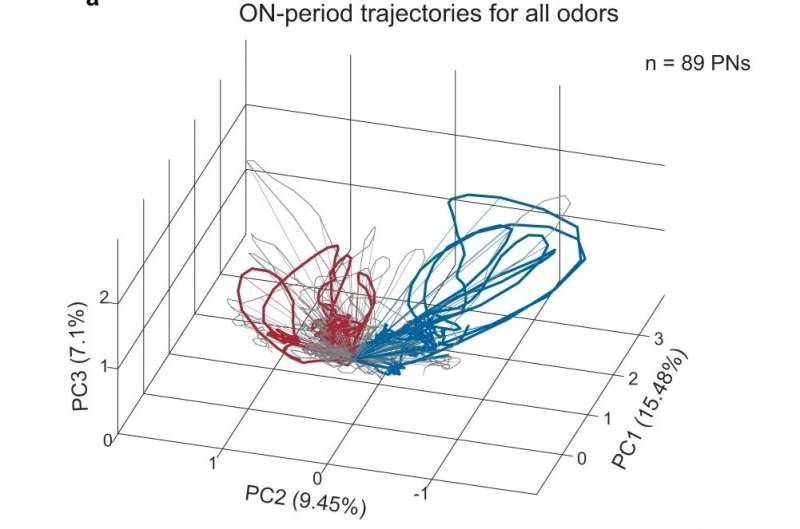This article has been reviewed according to Science X's editorial process and policies. Editors have highlighted the following attributes while ensuring the content's credibility:
fact-checked
peer-reviewed publication
trusted source
proofread
Good smells, bad smells: It's all in the insect brain

Everyone has scents that naturally appeal to them, such as vanilla or coffee, and scents that don't appeal. What makes some smells appealing and others not?
Barani Raman, a professor of biomedical engineering at the McKelvey School of Engineering at Washington University in St. Louis, and Rishabh Chandak, who earned bachelor's, master's and doctoral degrees in biomedical engineering in 2016, 2021 and 2022, respectively, studied the behavior of the locusts and how the neurons in their brains responded to appealing and unappealing odors to learn more about how the brain encodes for preferences and how it learns.
The study provides insights into how our ability to learn is constrained by what an organism finds appealing or unappealing, as well as the timing of the reward. Results of their research were published in Nature Communications.
Raman has used locusts for years to study the basic principles of the enigmatic sense of smell. While it is more of an aesthetic sense in humans, for insects, including locusts, the olfactory system is used to find food and mates and to sense predators. Neurons in their antennae convert chemical cues to electrical signals and relay them to the brain. This information is then processed by several neural circuits that convert these sensory signals to behavior.
Raman and Chandak set about to understand how neural signals are patterned to produce food-related behavior. Like dogs and humans salivating, locusts use sensory appendages close to their mouths called palps to grab food. The grabbing action is automatically triggered when some odorants are encountered. They termed odorants that triggered this innate behavior as appetitive. Those that did not produce this behavior were categorized as unappetitive.
Raman and Chandak, who earned the outstanding dissertation award from biomedical engineering, used 22 different odors to understand which odorants the locusts found appetitive and which they did not. Their favorite scents were those that smelled like grass (hexanol) and banana (isoamyl acetate), and their least favorites smelled like almond (benzaldehyde) and citrus (citral).
"We found that the locusts responded to some odors and not others, then we laid them out in a single behavioral dimension," Raman said.
To understand what made some odorants more likable and others not, they exposed the hungry locusts to each of the scents for four seconds and measured their neural response. They found that the panel of odorants produced neural responses that nicely segregated depending on the behavior they generated. Both the neural responses during odor presentation and after its termination contained information regarding the behavioral prediction.
"There seemed to be a simple approach that we could use to predict what the behavior was going to be," Raman said.
Interestingly, some of the locusts showed no response to any of the odors presented, so Raman and Chandak wanted to see if they could train them to respond. Very similar to how Pavlov trained his dog with a bell followed by a food reward, they presented each locust with an odorant and then gave them a snack of a piece of grass at different time points following the odor presentation.
They found that locusts only associated appealing scents with a food reward. Delaying the reward, they found that locusts could be trained to delay their behavioral response.
"With the ON-training approach, we found that the locusts opened their palps immediately after the onset of the odor, stayed open during the presentation of the odor, then closed after the odor was stopped," Raman said. "In contrast, the OFF-training approach resulted in the locusts opening their palps much slower, reaching the peak response after the odor was stopped."
The researchers found that the timing of giving the reward during training was important. When they gave the reward four seconds after the odor ended, the locusts did not learn that the odor indicated they would get a reward. Even for the appealing scents no training was observed.
They found that training with unpleasant stimuli led locusts to respond more to the pleasant ones. To explain this paradoxical observation, Raman and Chandak developed a computational model based on the idea that there is a segregation of information relevant to behavior very early in the sensory input to the brain. This simple idea was sufficient to explain how innate and learned preference for odorants could be generated in the locust olfactory system.
"This all goes back to a philosophical question: How do we know what is positive and what is negative sensory experience?" Raman said. "All information received by our sensory apparatus, and their relevance to us, has to be represented by electrical activity in the brain. It appears that sorting information in this fashion happens as soon as the sensory signals enter the brain."
More information: Rishabh Chandak et al, Neural manifolds for odor-driven innate and acquired appetitive preferences, Nature Communications (2023). DOI: 10.1038/s41467-023-40443-2
Journal information: Nature Communications
Provided by Washington University in St. Louis





















